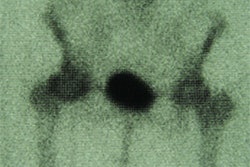VIENNA - Pulmonary echinococcosis is a painful and debilitating disease that has shown a 33% increase over the past 10 years in Dr. Adkham Ikramov’s practice in Tashkent, Uzbekistan. In a presentation today at the European Congress of Radiology, Ikramov described the results of a study that evaluates the roles of x-ray and CT in the diagnosis of pulmonary echinococcosis.
Ikramov, head of the radiology department at the Vakhidov Scientific Research Center in Tashkent, led a study to evaluate the need for CT of the chest after an initial x-ray in patients with pulmonary echinococcosis. He and his colleagues retrospectively reviewed chest x-ray and chest CT studies of 22 men and 16 women suspected of having echinococcosis.
Of the 38 patients in the study group, 10 men and 8 women had surgically verified echinococcosis of the lungs. Twelve of the patients had relapsed echinococcosis cysts after primary surgery. Both posterior/anterior (PA) and lateral chest x-ray views were obtained for diagnostic viewing. In addition, CT without contrast was performed on the patients at midinspiration level. The views were taken in supine position and at a slice thickness of 5 mm.
Subsequent image analysis revealed that in 31 of the 38 patients there was no difference between the x-ray and CT results. Only in 2 patients was the CT diagnosis of echinococcosis different from the diagnosis made by surgery, which uncovered tubercles cavern and malignant cystic tumors in those patients.
In seven patients the x-ray results differed from those of CT. These patients were initially interpreted as having pulmonary echinococcosis. In three of the cases the actual diagnosis was tuberculous cavern, and in the other four cases tumors of the lungs were the correct diagnosis. The CT studies were correct in five of seven cases.
The surgically identified multiple cysts in both lungs of the18 patients were all seen by CT; however, x-ray studies were only helpful in this diagnosis when the cysts were larger than 1 cm in diameter.
Ikramov and his group advocate that a CT study of the chest should follow a chest x-ray study for pulmonary echinococcosis in following situations:
- Numerous cysts in one or both lungs
- Sonographic appearance of complicated echinococcosis (suppuration, breakthrough to bronchus or pleural cavity)
- Difficult interpretation of chest X-ray because of superimposed soft tissue, or
- Relapsed echinococcosis cysts.
AuntMinnie.com staff writer
March 4, 2001
Click here to post your comments about this story. Please include the headline of the article in your message.
Copyright © 2001 AuntMinnie.com




















